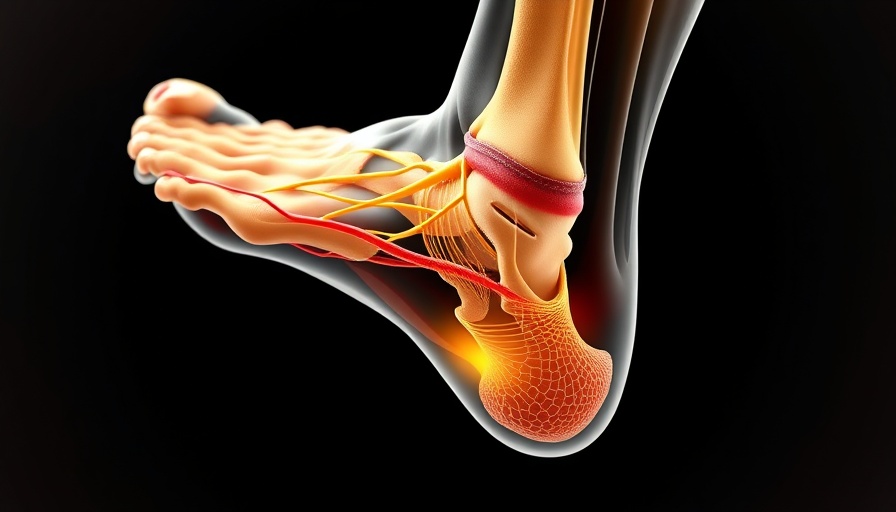
The Hidden Risks of Tarsal Tunnel Syndrome in Pickleball Players
As the sport of pickleball gains popularity, so do the injuries associated with its fast-paced gameplay, particularly those related to the lower body. One common yet often overlooked condition is tarsal tunnel syndrome (TTS), which affects players by causing discomfort and limiting movement on the court. Understanding this condition is vital for maintaining ankle and foot health, ensuring players can enjoy the game without facing debilitating pain.
What is Tarsal Tunnel Syndrome?
Tarsal tunnel syndrome arises when the posterior tibial nerve, which runs along the inner side of the ankle, becomes compressed. This narrow space, known as the tarsal tunnel, houses vital nerves and tendons crucial for foot and ankle movement. Compression can lead to a cocktail of symptoms, including tingling, numbness, and sharp pain primarily experienced in the foot and inner ankle. The condition often stems from repetitive strain, trauma, or pre-existing conditions such as diabetes and arthritis. For pickleball enthusiasts, the sudden bursts of activity coupled with the wear and tear from lateral movements can significantly increase the risk of developing this syndrome.
Why Players Should Be Aware of Their Foot Health
During pickleball games, players may not consider how the terrain and their foot mechanics contribute to increasing the risk of foot injuries, including TTS. The sport often involves dynamic movements that can strain the feet and legs. Symptoms may arise from simple overuse, such as frequent pivoting and working to maintain balance. For players with flat feet, this strain is more pronounced, elevating their risk of compression of the tibial nerve due to altered biomechanics.
Recognizing Symptoms Early Can Make a Big Difference
Understanding the symptoms of tarsal tunnel syndrome is critical for early intervention. Players affected by TTS may experience burning sensations in the foot or notice a feeling of weakness when pushing off during play. Addressing these symptoms promptly can make a notable difference in outcomes. If you notice signs of discomfort, consulting a podiatrist can help establish an effective treatment plan before the pain exacerbates.
Preventive Steps Tailored for Pickleball Players
Prevention is crucial in avoiding tarsal tunnel syndrome and other common injuries related to pickleball. Here are several actionable tips to help protect players:
- Choose Supportive Footwear: Proper shoes with adequate arch support can significantly reduce strain on the feet and help in mitigating the risk of developing TTS.
- Incorporate Stretching and Strengthening Exercises: Regular ankle and calf stretches can improve flexibility, allowing the foot to withstand the demands of the game. Ankle strength exercises can help rebuild stability, providing better support during play.
- Warm-Up Before Playing: A proper warm-up focusing on dynamic stretching can prime the body for the sport’s demands, reducing the chance of injuries.
- Gradual Increase in Play: For players new to pickleball or returning after a break, gradually increasing playtime allows the body to adjust better, minimizing the likelihood of strain-related injuries.
Is It Time to Seek Professional Guidance?
Players experiencing symptoms related to tarsal tunnel syndrome should consult with a qualified podiatrist. Diagnosis can involve physical examinations, tapping on the nerve to elicit symptoms, and possibly imaging studies to visualize any underlying issues. Your podiatrist might recommend various treatment options, including rest, anti-inflammatory medications, or, in advanced cases, surgical intervention to relieve pressure on the nerve.
Conclusion: Aiming for Long-Term Health in Pickleball
As pickleball continues to captivate enthusiasts of all ages, awareness of conditions like tarsal tunnel syndrome is essential. By recognizing the signs, taking preventive measures, and seeking professional help when necessary, players can safeguard their foot health and maintain a robust game. Don’t let injuries diminish your enjoyment of the sport; prioritizing your wellness now will help you continue your pickleball journey for years to come!
 Add Row
Add Row  Add
Add 




Write A Comment